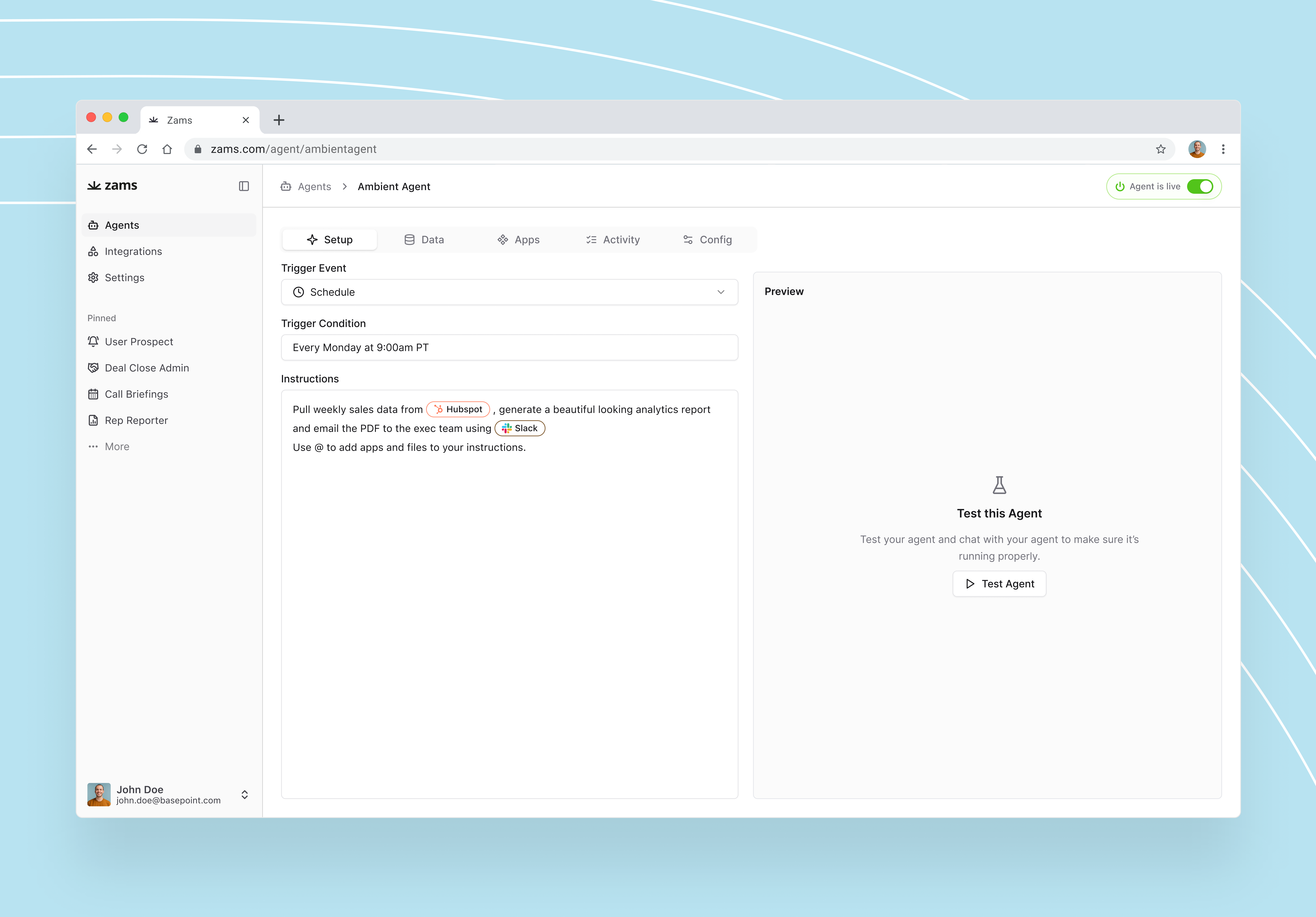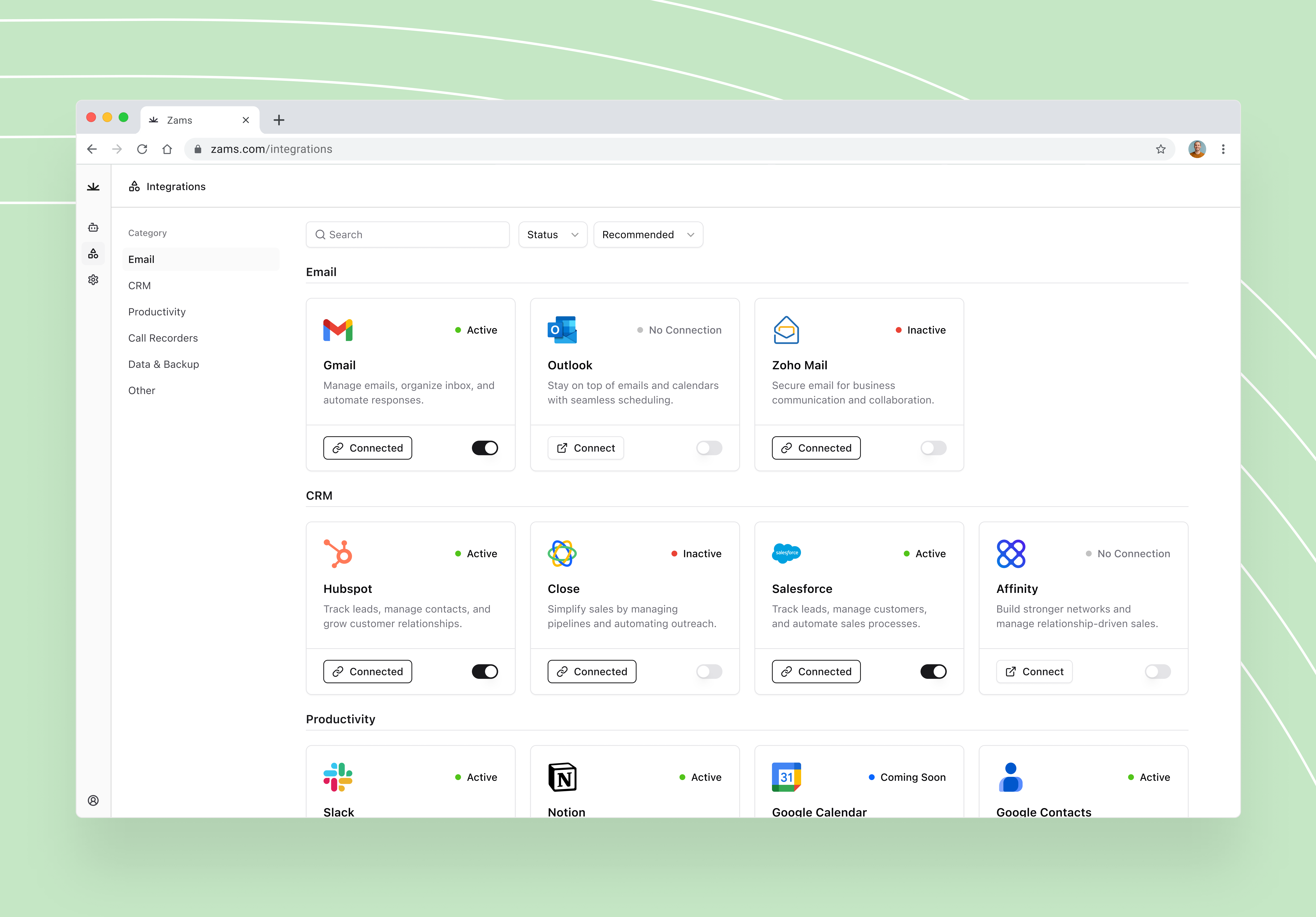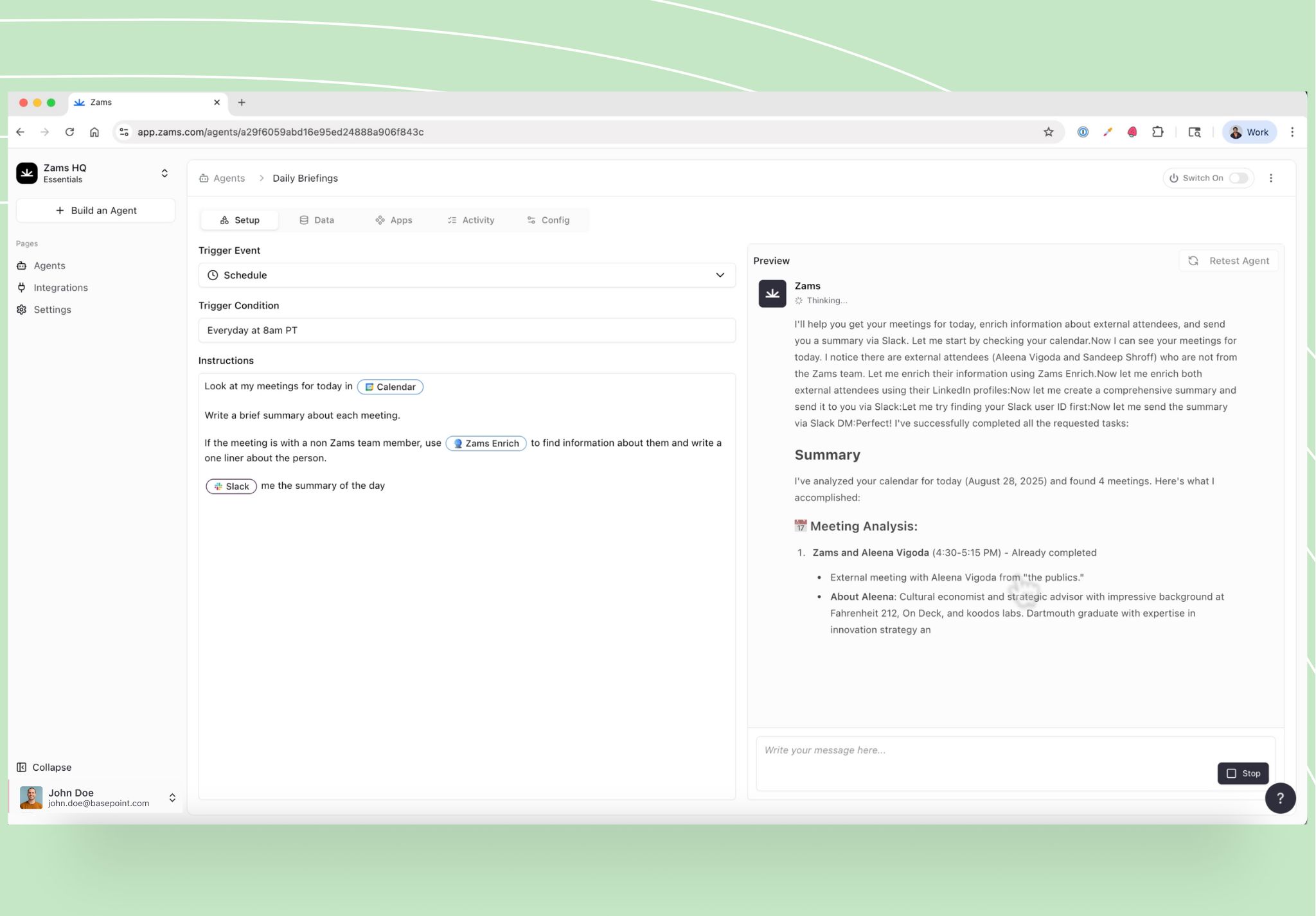Introduction to Slack
Slack boasts millions of active users, reflecting its widespread adoption and popularity among organizations worldwide. The company behind Slack originated as Tiny Speck, later evolving into a leading business-to-business platform before being acquired by Salesforce. Slack is accessible on multiple platforms, including Windows, Linux, and macOS, ensuring broad compatibility for users on different operating systems. Did you know, Zams lets you connect Slack with hundreds of the most popular apps? Meaning you can automate your work and have more time for what matters most - closing revenue.
With Slack as part of your cloud-based collaboration tools, your team can streamline team collaboration and real-time communication across projects.
Key Features of Slack
Slack offers a robust set of features that make team collaboration fast, organized, and efficient. From dedicated channels to seamless integrations with other collaboration tools, Slack adapts to the way your team works. Whether you need quick updates, private messages, file sharing, or video conferencing group conversations, Slack’s features keep everything in one place, making it one of the best collaboration tools for businesses.
Slack Channels (public vs private)
Slack channels are the heart of the platform, allowing teams to organize conversations by project, topic, or department. Public channels are open for anyone in the workspace to join, promoting transparency, while private channels (also known as private messages) are invite-only spaces for confidential conversations, keeping sensitive discussions secure. This flexibility ensures teams can collaborate effectively while maintaining the right level of privacy nd enabling project management in a centralized environment.
Integrations & Apps - The ultimate workflow builder
One of Slack’s most powerful features is its ability to integrate with hundreds of popular apps through seamless integration with various services like Google Drive, Trello, and Zoom. These integrations let you share files, track projects, and host meetings without leaving Slack. By centralizing your workflow, Slack reduces the need to switch between multiple collaboration platforms.
You can install apps such as Google Calendar and Dropbox to enhance scheduling, file sharing, and workflow automation within Slack. These integrations allow Slack to serve as a central hub for multiple business services.
Zams supercharges B2B sales teams with a sales automation engine right inside Slack. Teams get real-time communication, deal alerts, meeting prep summaries, and lead assignments in their channels - plus the power to update CRM records and trigger workflows without leaving Slack. It’s sales acceleration without the tab-switching.
Learn how to connect slack with Zams with our helpful integration guide.
Messaging & Threads
Slack’s messaging system supports both private messages and organized threads, helping teams keep group conversations focused and easy to follow. Threads prevent main channels from becoming cluttered while allowing side discussions to stay connected to the original topic. This structure makes it simple to track decisions and updates,enhancing team collaboration. Teammates can use reactions, such as emojis, to quickly respond to messages and enhance engagement within threads, making collaboration more interactive and efficient.
Voice & Video Calls
Slack includes built-in voice and video call functionality, enabling quick conversations without scheduling a formal meeting. These calls work seamlessly with channels or direct messages, making it easy to jump from chat to face-to-face discussions. During calls, participants can use the mute feature to silence themselves and the record feature to capture important discussions for later reference. For larger meetings, Slack integrates with Zoom and other conferencing tools.
Search & Message History
Slack’s powerful search feature lets you quickly find messages, files, and shared links across all channels. With advanced filters and keyword search, you can retrieve important information in seconds. Slack acts as a central knowledge base within cloud-based collaboration tools, by making all conversations and documents easily searchable, ensuring your team’s collective knowledge is always accessible. For teams on paid plans, Slack offers an extensive message history so nothing gets lost over time.

How to Use Slack for Team Communication
Knowing how to use Slack effectively can transform the way your team collaborates and shares information. Whether you’re looking for simple Slack tips or advanced productivity hacks, the platform offers cloud-based collaboration tools that work equally well for in-office and remote teams. With features like structured channels and workflow tools, and real-time communication, Slack helps teams stay organized and automate everyday tasks, streamlining routine work activities and keeping collaboration efficient. With the right setup, Slack can become the central hub for all your team communication.
Setting up your workspace
Setting up your Slack workspace is the first step toward a more connected team. You’ll create a workspace name, invite team members, customize settings, and customize or rename channels and apps to fit your team's workflow to match your organisation’s needs. Taking the time to configure channels, permissions, and integrations from the start ensures smoother collaboration later.
Organising channels by project or department
Organising Slack channels by project or department helps keep discussions focused and easy to follow. This structure allows team members to quickly find relevant conversations without being distracted by unrelated topics. Clear channel naming conventions can make a huge difference in overall productivity and support effective team collaboration.
Managing slack notifications
Slack notifications are powerful, but without proper management, they can become overwhelming. By adjusting notification preferences per channel or conversation, you can stay informed without constant interruptions. This balance helps maintain productivity while ensuring you never miss important updates.
Best practices for remote work with Slack
Slack for remote teams works best when combined with clear communication guidelines and consistent check-ins. Use channels for team-wide updates, direct messages for quick questions, and threads to keep discussions organized. Slack also enables remote teams to collaborate efficiently not only internally but also with external partners and vendors, supporting project management and streamlining cross-organizational communication and ensuring everyone stays aligned. This approach reduces confusion and fosters a stronger sense of connection in remote settings.

Slack Connect Integrations and Automation
Slack integrations allow you to connect your favourite productivity tools directly into your workspace, reducing the need to switch between apps. Whether it’s file storage, task management, or video conferencing, integrations streamline your workflow and save time by allowing you to automate repetitive tasks and processes. With the right setup, Slack becomes a central hub for both communication and work execution.
Top productivity apps to connect: upgrade your sales cycle
Popular Slack integrations include Google Drive for file sharing, Trello for project management, and Zoom for meetings. Connecting these apps brings essential tools into one platform, making it easier to share updates and collaborate in real time. By choosing integrations that match your workflow, you can significantly boost efficiency. See how you can connect your existing workflow to Zams today.
Using Slackbot for reminders and updates
Slackbot, your built-in virtual assistant, can help with everything from sending reminders and setting up automated reminder workflows to providing quick answers to common questions. You can program custom responses or set automated alerts for deadlines, meetings, or project milestones. This simple automation feature reduces the mental load on your team.
Automating repetitive tasks with Slack workflows
Slack’s Workflow Builder allows you to create automated processes for routine tasks like onboarding, feedback collection, or status updates. This workflow builder saves time by removing repetitive manual steps and ensuring consistency. Workflows can be used to submit a request, manage incoming requests, and automate processes such as time off requests. Additionally, workflows can be marked as completed or deleted when they are no longer needed. With automation in place, teams can focus more on strategic work and less on admin tasks.
Slack Pricing and Plans
Slack pricing is designed to fit teams of all sizes, from small startups to large enterprises. With options ranging from the Slack free plan to premium tiers and the advanced Slack Enterprise Grid, you can choose a package that matches your needs and budget. Understanding what each plan offers will help you get the best value for your team.
Upgrading to Slack Pro or higher tiers unlocks advanced features such as project templates, integrated app management, and AI-powered tools, providing enhanced functionality and integrations for your workflow.
Free vs Paid versions
- The Slack free plan provides essential messaging and collaboration features, making it a great option for small teams or trial use.
- Paid versions unlock advanced tools such as unlimited message history, enhanced security, and priority support.
- Choosing between free and paid comes down to your team size, workflow complexity, and growth plans.
Feature breakdown for each plan
Each Slack plan - Free, Pro, Business+ and Enterprise Grid - offers a distinct set of features. Pro adds more integrations and extended history, while Enterprise Grid provides advanced security and organisational tools. This breakdown helps teams identify the features they need without paying for extras they won’t use.
Which plan is best for your team?
The right Slack plan depends on your team’s size, industry, and collaboration requirements. Small teams may thrive on the Free or Pro plan, while large organizations with strict compliance needs will benefit from Enterprise Grid. Assessing your current and future needs ensures you invest in the right tier from the start.

Slack Security and Privacy
Slack security is built to safeguard sensitive business communications through strong encryption and compliance with industry standards. From protecting message data to ensuring user privacy, Slack takes a multi-layered approach to security. Businesses can rely on it for safe and compliant workplace communication.
How Slack protects your data
Slack uses enterprise-grade encryption to secure messages and files both in transit and at rest. Regular security audits and monitoring ensure vulnerabilities are quickly identified and addressed. This commitment to data protection gives teams peace of mind when sharing sensitive information.
Admin controls and permissions
Slack offers powerful admin controls to manage user access, set permissions, and monitor workspace activity. These tools help maintain a secure environment while still enabling smooth collaboration. With granular control, administrators can tailor access levels to match each team member’s role.
Compliance with GDPR, SOC 2, HIPAA
Slack meets key compliance standards like GDPR, SOC 2, and, for eligible plans, HIPAA. This makes it suitable for industries with strict data protection and privacy requirements. By aligning with these frameworks, Slack ensures that your team’s communication remains legally compliant and secure.
In summary
The Slack app has earned its place as a top choice for businesses thanks to its intuitive design, powerful integrations, and flexible communication features. As a team communication software, it streamlines collaboration for both in-office and remote work environments. For organizations seeking an all-in-one remote work tool, Slack offers the balance of simplicity and capability that keeps teams connected and productive.
With Zams integrated into Slack, you can turn every message into action - see how it accelerates your sales workflow today.
FAQs about Slack
What is Slack used for?
Slack is a team communication and collaboration platform that helps teams chat, share files, and integrate tools in one central workspace. It’s used by companies of all sizes to improve productivity and streamline communication.
Is Slack free to use?
Yes, Slack offers a free plan with core messaging features, plus paid plans that provide advanced tools, integrations, and enhanced message history for larger or more complex teams.
How is Slack different from Microsoft Teams?
Slack focuses on channel-based communication and an extensive range of third-party integrations, while Microsoft Teams is deeply embedded in the Microsoft 365 ecosystem, making it ideal for organizations already using those tools.
Is Slack secure for business use?
Slack uses enterprise-grade encryption and meets security certifications like SOC 2, ensuring that business communications remain safe and private. Admin tools allow for granular control over permissions and data access.
Can I use Slack on mobile devices?
Yes, Slack has dedicated iOS and Android apps that keep messages, files, and channels synced across devices, making it easy to stay connected on the go.



